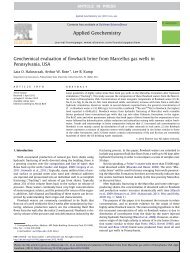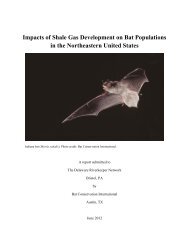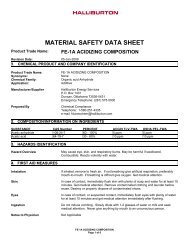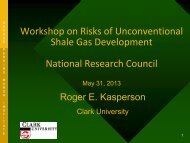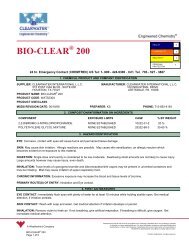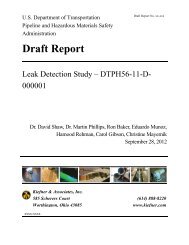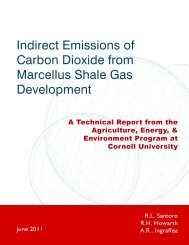Gulf Coast Coal and Petrochemical Facilities Still Not Storm Ready
Gulf Coast Coal and Petrochemical Facilities Still Not Storm Ready
Gulf Coast Coal and Petrochemical Facilities Still Not Storm Ready
Create successful ePaper yourself
Turn your PDF publications into a flip-book with our unique Google optimized e-Paper software.
– 9 –<br />
GRN’s Jonathan Henderson collecting oil samples from a marsh at<br />
Bay Batiste after Hurricane Isaac.<br />
Photo Credit: GRN<br />
Oil samples from the marsh in Bay Batiste<br />
were sent to Dr. Ed Overton at Louisiana<br />
State University for analysis. Dr. Overton<br />
found that the fingerprint of oil samples<br />
taken in Bay Batiste matched that of oil<br />
from BP’s failed Macondo well,<br />
suggesting that oil from the BP /<br />
Deepwater Horizon disaster continues to<br />
resurface on the Louisiana coast during<br />
storm events. In addition, nearly a month<br />
after Hurricane Isaac, GRN conducted a<br />
ground investigation <strong>and</strong> documented<br />
more oil, also confirmed by Dr. Overton 16<br />
to be from the BP/<strong>Gulf</strong> Oil Disaster, still<br />
polluting marshes <strong>and</strong> shorelines on<br />
Elmer’s Isl<strong>and</strong> <strong>and</strong> Gr<strong>and</strong> Isle.<br />
Summary:<br />
The abundance of pollution caused by a relatively routine <strong>and</strong> predictable storm indicates deficiencies<br />
in the condition, maintenance, <strong>and</strong>/or operations of fossil fuel <strong>and</strong> petrochemical facilities in the <strong>Gulf</strong><br />
Region. The vulnerability of facilities that contain <strong>and</strong> process oil, coal, petroleum coke, natural gas,<br />
<strong>and</strong> a wide range of hazardous chemicals <strong>and</strong> gases could lead to catastrophic effects in more<br />
severe storms. A preponderance of evidence shows that extensive pollution caused by storm damage<br />
is not isolated to Hurricane Isaac:<br />
● In 2004, Hurricane Ivan, a Category 3 storm, created a sub-sea l<strong>and</strong>slide that wiped out Taylor<br />
Energy Platform #23051 off the Louisiana coast. Nearly nine years later crude oil continues to<br />
ooze into the waters of the <strong>Gulf</strong>, as detailed in GMC’s 2011 report 17 .<br />
● In 2005, Hurricanes Katrina <strong>and</strong> Rita devastated the <strong>Gulf</strong> <strong>Coast</strong> 18 . According to a report to<br />
Congress from the U.S. <strong>Coast</strong> Guard 19 , the NRC logged over 5,000 minor spill incidents from<br />
the storms. Over nine million gallons of oil were released from coastal <strong>and</strong> offshore facilities,<br />
including six major <strong>and</strong> five medium spills. Furthermore, the U.S. Minerals Management<br />
Service 20 reported that the two storms totally destroyed 113 offshore oil <strong>and</strong> gas platforms <strong>and</strong><br />
damaged 457 pipelines, including 101 large pipelines (>10" in diameter).<br />
● In 2008, the Associated Press (AP) reported 21 that Hurricane Ike, a Category 2 storm, caused<br />
“at least 448 releases of oil, gasoline <strong>and</strong> dozens of other substances into the air <strong>and</strong> water<br />
<strong>and</strong> onto the ground in Louisiana <strong>and</strong> Texas.” Aerial photos showed extensive sheen <strong>and</strong> oil<br />
slicks on floodwaters near Galveston, around High <strong>and</strong> Goat Isl<strong>and</strong>s in Texas, <strong>and</strong> on flooded<br />
l<strong>and</strong>s in Southern Louisiana 22 .<br />
<strong>Gulf</strong> industrial facilities continue to show disturbing susceptibility to damage from the annual barrage<br />
of strong, yet predictable, summer storms, with <strong>Gulf</strong> <strong>Coast</strong> residents <strong>and</strong> the environment repeatedly<br />
paying the price. As the public <strong>and</strong> our elected officials consider exp<strong>and</strong>ed drilling in the <strong>Gulf</strong> of<br />
Mexico, on the Eastern Seaboard, <strong>and</strong> in the Arctic Ocean, coupled with the increased export of<br />
domestically produced fossil fuels to foreign markets, it is imperative that this vulnerability be<br />
recognized <strong>and</strong> addressed by natural resource development plans <strong>and</strong> regulations that safeguard our<br />
Nation’s waters <strong>and</strong> coastal residents.



